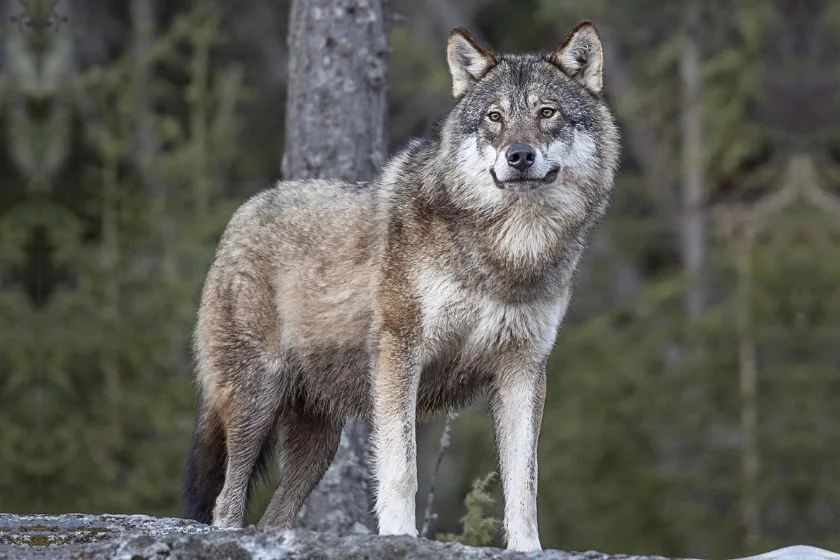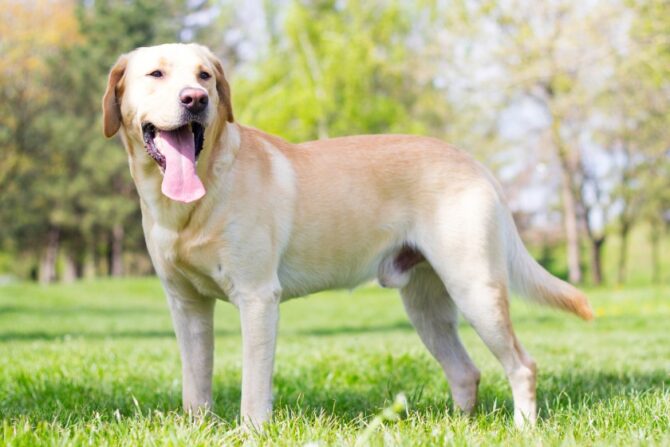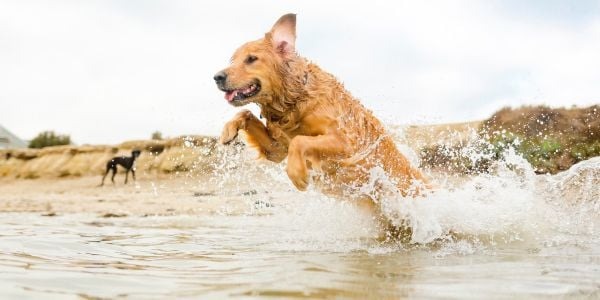Discover the differences and similarities between dogs and wolfs in this comparison—which is stronger?
Dogs are descendants of wolves and are, therefore, related to them.
They are, in fact, domesticated wolves that changed due to evolution, which makes them relatively weaker. In light of this, can a dog kill a wolf?
Wolves are wild animals and extremely dangerous. They possess high survival instincts and are natural predators; you want to avoid crossing paths with them in their natural environment.
Dogs are watered-down versions of wolves and are relatively safer. In most cases, dogs cannot kill wolves.
Dog vs Wolf: What are the Differences Between Dogs and Wolves?
Although dogs and wolves are both part of the canine species, they are very dissimilar in many aspects.
Physical Differences

Dogs are much more slender than wolves. Their heads are smaller than those of their wolf cousins, with their facial structures differing.
Dogs have rounder faces and more prominent eyes than wolves.
They do have the same number of teeth (42, to be precise), though those of the wolf are very much sharper because it needs to crunch bones in the wild.
It possesses pointed ears and long tails, while dogs’ ears are fluffy and their tails short or curly.
Both animals bark, although a wolf’s bark is a combination of sounds (a growling bark, a howling bark).
They are more likely to howl; it’s how these wild canines communicate.
Their eye colors also differ immensely. Dogs’ eye colors vary from blue to muddy brown.
Meanwhile, wolf’s eye colors are usually shades of amber and yellow, never brown.
The color of a wolf’s coat is either black, grey, white, or brown because their survival highly depends on their ability to conceal themselves.

Dogs, on the other hand, do not need camouflage to survive; the color of their coat can be any shade.
Wolves have long legs and slender chests; dogs’ legs tend to be stockier, and their chests are wider.
These animals attain physical maturity at two different ages: dogs at 6-8 months and wolves at 2-3 years.
Female wolves have one cycle a year, while dogs normally have two.
However, domesticated dogs have all their needs catered to; they can reproduce year-round.
Behavioral Differences
Dogs are much more outgoing than their wolf cousins, and when given adequate affection and care, they can form strong attachments with their human companions.
It makes them very protective of their humans. Wolves are shy creatures, and it is advised not to approach them because they rarely bond with people.
They prefer to move in packs; it makes hunting easier and increases their chances of survival.
Their packs are their family, so they can kill to protect them.
Wolves are much more mentally mature than dogs. A 6-month-old wolf will find it easier to solve puzzles than a 2-year-old dog.
This is because their survival in the wild depends on their ability to adapt, while domesticated dogs are under no such stress.
Both animals love digging. Dogs do it because of their adventurous natures; wolves, on the other hand, dig as a necessity.
They dig on the hunt for food, make dens for their pups, and, last but not least, create cold spots during extremely hot weather.
Dogs and wolves have slightly dissimilar dietary tastes. Wolves eat meat and are fully carnivorous.
They prefer to hunt down big game for consumption (elk, moose, deer, hyenas), and in absence of these, they make do with smaller creatures (rabbits, foxes, birds).
Dogs love meat almost as much as wolves. However, due to their domesticated natures and their constant contact with humans, they’ve adapted and opened up to the possibility of other sorts of food.
Can a Dog Kill a Wolf?
Wolves are vicious untamed creatures that constantly kill for survival.
They have sharp claws, and their body structure (strong jaws, lean build) puts them in the ranks of extremely dangerous creatures.
So, no. In most cases, a dog cannot kill a wolf. However, a wolf’s ability to kill a dog is based on its bite force.
The wolf’s bite force is estimated at 400 PSI (Pound per Square Inch), and a human’s average bite force is 162 PSI.
There are some breeds of dogs that possess bite forces that are equal and even superior to wolves’ bite forces!
On the off chance a dog from one of these breeds can avoid being mauled by a wolf, it may just emerge victor of their fight.
Here are eleven dog breeds that can kill a wolf:
1. Dogo Argentino
Bred in Argentino, it is used in search and rescue situations, as a service dog, or in military work.
They are strong, very loyal, intelligent, courageous, and have a high prey drive.
This makes them excellent guard dogs: they will scare away or attack intruders. Their bite force is estimated at 500 PSI which is higher than a wolf’s.
2. Caucasian Shepherd Dog
It is one of the biggest protective dogs in the world; it has superior strength and is also very alert.
When well-trained, they safeguard their homes and keep intruders and predators at bay.
This can be chalked up to their protective and territorial instincts. Their bite force ranges between 550 PSI to 700 PSI.
3. Anatolian Shepherd Dog
Also known as the Kangal is a Turkish dog that has been bred through the centuries as a household guard dog.
They are highly affectionate and gentle, which is a trait rarely found in breeds as strong as theirs.
With their bite force ranked at 743 PSI, they can successfully battle wolves, coyotes, cheetahs, leopards, and even bears.
So if you’re looking for a dog that can kill a wolf, the Anatolian Shepherd Dog is one of your best bets.
The Kangal are hard to obtain as they are very prized and important to the Turk; their exportation has been made illegal.
4. Šarplaninac
Often referred to as the Illyrian Shepherd Dog, it has been used as a household and livestock guard for centuries.
Due to this, their natural protective and herding instincts are very high.
The Šarplaninac is also a very intelligent creature, and this comes with its inconveniences.
When improperly trained, it can decide whether or not to obey orders given to it by its master.
This can be avoided by training the dog decently from a young age, and although they require a bit of time to get used to humans, they become loyal and faithful with time.
This breed’s bite force ranges from 450 PSI to 700 PSI. It’s very much capable of killing a wolf.
5. Volkodav
Commonly known as the Central Asian Shepherd Dog, they are extremely courageous, perpetually alert and always up for a fight.
Although a popular Russian breed, they are a rarity in other households.
However, their thick coats enable them to withstand very cold temperatures: this simply means that they can protect their households even in the chilliest of the winter months.
When relaxed, they’re very calm, nice dogs; in other words, the perfect human companion.
With a bite force rated between 450 PSI to 500 PSI, they’re ideal for fending off wolves.
These dogs also have an insatiable appetite for fighting and protecting. They attack determinedly and won’t stop until there is a winner.
6. Irish Wolfhound
Do you want a dog that is family-friendly, protective, strong, and loyal? Get yourself an Irish Wolfhound!
Originally from Ireland, they are trusted guard dogs and will do anything to defend their pack.
Their bite force ranges between 250 PSI and 400 PSI, which is almost the same as a wolf’s.
They are well-matched, and what will enable an Irish wolfhound to win will be the protective feelings it has for its pack.
This calm, kind-hearted version of the Irish Wolfhound emerges only when trained consistently and diligently.
Show them you’re re deserving of their loyalty, and they’ll fight for you.
They can’t cope with boredom and may end up being destructive when put in such a situation.
7. Tibetan Mastiff
The Tibetan Mastiff is a giant among dogs and underneath its furry bulky exterior is hidden a well-muscled body that makes them powerful.
Their bodies have adapted to their local environment, which makes them capable of withstanding extremely cold temperatures.
They are great guard dogs for cold areas. Their bite force is estimated at around 560 PSI.
The Tibetan Mastiff is a good family dog and can be an excellent one when raised alongside children from a tender age.
As they get older and larger, however, it’s not safe for them to be around younger children.
Despite their size, they’re very healthy and are long-lived, with a lifespan extending to 15 years.
A vital piece of information about the Tibetan Mastiff is that they have a big sense of prey drive and a huge sense of loyalty.
This simply means that they can fight a wolf…and kill. Their territorial instincts make them deadly; they’ll attack anything considered an Intruder.
8. Armenian Gampr Dog
The Armenian Gampr Dog is a well-respected breed that can be loved and feared, depending on the side of the fence you’re on and your intent.
They are a result of breeding with wolves and possess some of their particular traits: loyalty, protectiveness, independence, high prey drive, self-preservation instincts, and good defensive skills.
This makes them excellent guard dogs and is one of the reasons why they have been livestock guard dogs for centuries.
Their scary nature makes it hard for them to warm up to new owners, but once they do, they are extremely loyal companions.
The Armenian Gampr Dog can endure harsh weather conditions and is recommended to people living in such areas.
Their bite force is between 450 PSI to 650 PSI which is significantly superior to a wolf’s.
Therefore, they are more than capable of dealing with wolf threats.
9. Italian Mastiff
Also known as the Cane Corso, the Italian Mastiff is a reliable, strong, and friendly dog.
Although it looks dangerous with its big head and well-built body, it is not an aggressive breed by nature and is not likely to attack strangers.
They can be brought up at a young age around small children by a determined and experienced dog owner.
They are very loyal to their owners once committed and would do anything to defend them.
The Cane Corso has an extremely high prey drive and is very protective.
With their bite force ranking at 700 PSI and their amiable natures, they make perfect guard dogs and are perfect for dealing with wolf threats.
10. Presa Conario
Popularly known as the Canary Mastiff, the Presa Conario are good livestock guardians and can become extremely loyal when well taken care of.
This makes them extremely protective of their charges: be it livestock or people.
Temperament-wise, they are a very suspicious breed by nature and don’t do well with strangers or small children.
A firm and experienced hand is needed in their training; it should be debuted from a young age.
Their bite force at 540 PSI attains and surpasses that of a wolf which is at 400 PSI.
Presa Conario’s have a high prey drive which, when combined with their suspicious nature and superior bite force, makes them good candidates to affront and possibly kill a wolf.
11. Boerboel
The Boerboel is known for its possessive and controlling nature.
This makes it an excellent guard dog when well trained due to its need to protect what’s seen as members of his pack (could be livestock, people, or both).
They possess a very high prey drive which makes it very probable that they’d head off strangers and intruders or attack them.
Also known as the South African Mastiff, their bite force is rated at 450 PSI. It is more powerful than a wolf.
They’re best suited for people with older children because of their size and disposition.
They hardly shed and, when properly trained from a young age, become very sociable and nice.
Do not go for this specie if this is your first time raising a dog.
Dog vs Wolf: Who Would Win?
Dogs and wolves are similar in so many aspects and differ in a lot more.
Although dogs are descendants of wolves, their physical and behavioral attributes are dissimilar thanks to evolution and constant intra- and inter-breeding.
This resulted in the creation of some species of dogs that can comfortably battle and kill wolves.
They can only do this in the case of a one-on-one fight, but seeing as wolves move as a pack, it is not likely a dog would survive such an experience.






